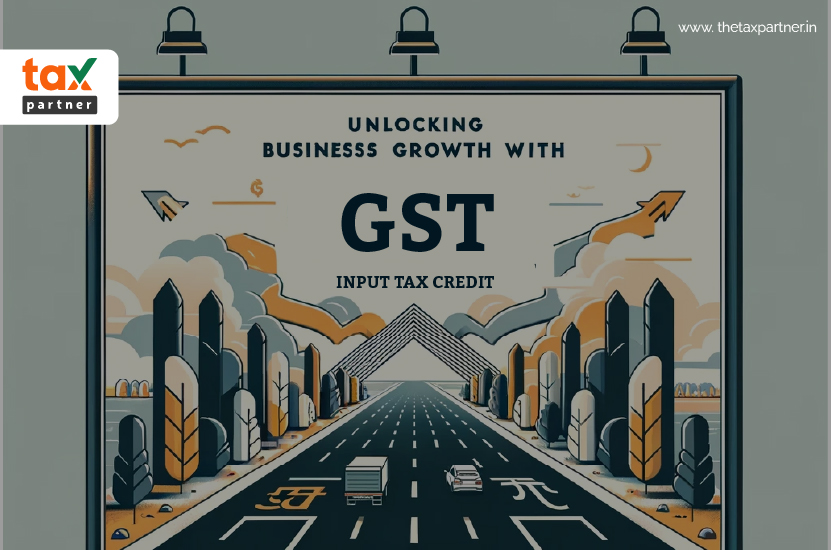INPUT TAX CREDIT (ITC) UNDER GST
INPUT TAX CREDIT (ITC) UNDER GST
AUTHOR-TANVI THAPLIYAL
Paying taxes is not a choice but duty, but it should never feel like an undue burden. Tax laws and regulations should be designed to prevent complications like double taxation. In alignment with this principle, the Input Tax Credit (ITC) was introduced. Through ITC, businesses can reclaim the tax paid on their input purchases. This reclaimed amount can then be utilised to offset the GST owed on their sales. This mechanism ensures that taxation enhances fairness and efficiency without imposing unnecessary financial strains on businesses. ITC was introduced so as to reduce the tax liability as it makes a sale by claiming the credit depending on how much GST was paid on the business purchases. In this article we will discuss the intricacies of input tax credit alongwith its compliance, importance and method of filing.
Why understanding ITC is crucial for businesses-
-
Enhances Cash Flow:ITC enables businesses to receive a credit for the tax paid on inputs, which can then be utilised to reduce their GST liabilities on sales. This mechanism greatly enhances cash flow management by decreasing the actual cash outflow for taxes.
-
Decreases Cost of Goods and Services:By utilising ITC, the total cost of production or acquisition of goods and services can be reduced. This decrease can either boost the profit margin for businesses or allow them to set prices for their goods or services more competitively.
-
Eliminates the cascading effect of taxesby ensuring tax is not paid on top of tax at each stage of the supply chain. Comprehending ITC guarantees that businesses only pay tax on the value addition, enhancing the system's fairness and transparency.
-
Ensures Compliance:It is crucial to have a thorough grasp and implementation of ITC to comply with GST laws. Failure to comply, whether from lack of knowledge or carelessness, may result in penalties, interest, or other legal repercussions.
-
Enables Precise Tax Filing:Understanding ITC rules is crucial for accurate GST filing and reporting. Mistakes in claiming ITC can cause discrepancies in the GST portal, leading to notices from tax authorities, delayed refunds, or rejection of credit claims.
-
Facilitates Strategic Decision Making:Understanding of ITC can impact business choices, like choosing suppliers according to their GST compliance, which in turn impacts the eligibility and accessibility of ITC. It also assists in strategizing purchases and use of resources to maximise tax credit advantages.
-
Enhances Audit Readiness:Familiarity with ITC helps businesses get ready for GST audits. It guarantees that all ITC claims are valid, backed by appropriate documentation, and in line with regulations, reducing the chances of audit issues and fines.
-
Improves Financial Planning and Reporting:Efficiently managing ITC is crucial for financial planning and reporting. It affects profitability and tax liability, which are essential for internal decision-making and external reporting to stakeholders.
How CGST Regime Illustrates ITC
These are the main sections related to ITC as specified in CGST Act,2017:
-
The term "Input Tax" is defined in Section 2(57) of the CGST Act. It encompasses the Integrated Goods and Services Tax (IGST), Central Goods and Services Tax (CGST), and State Goods and Services Tax (SGST) levied on any goods or services supplied and utilised or intended to be utilised for business purposes.
-
The meaning of"Input" is provided in Section 2(54) of the CGST Act, which refers to goods utilised or planned to be utilised by a supplier in the course of conducting business.
-
The term"Capital Goods" is defined in Section 2(19) of the CGST Act as goods whose value is capitalised in the books of accounts of the individual claiming the input tax credit and are used or intended to be used in the course or furtherance of business.
-
The meaning of "Input Service" is outlined in Section 2(55) of the CGST Act, which states that it refers to any service utilised or planned to be utilised by a supplier in the conduct or advancement of business.
-
Conditions for Availing Input Tax Credit:Section 16 of the CGST Act outlines the requirements for claiming input tax credit. The guidelines state that a registered individual can only claim ITC if specific conditions are fulfilled, like having a tax invoice or debit note, receiving goods or services, supplier paying the tax, etc.
-
There is a specific time limit for claiming input tax credit under Section 16(4) of the CGST Act. It mentions that ITC cannot be claimed after the due date for filing the return under section 39 for the month of September following the end of the financial year to which the invoice or debit note relates, or filing the annual return, whichever comes first.
Understanding ITC With An Example
For example,
let's assume that "TechnoGadgets Pvt. Ltd." is a smartphone maker. Think about their raw material purchases and their final goods sales:
-
To begin making cellphones, TechnoGadgets Pvt. Ltd. sources its raw components from an authorised vendor, including processors, displays, batteries, and plastic housings.
-
With an applicable GST rate of 18% on raw materials, the total purchase value amounts to ₹1,00,000.
-
Buy Price: ₹1,00,000
-
Excise Duty: 18%
-
The purchase tax amount was ₹18,000, which is 18% of ₹1,00,000.
Production and Distribution of Smartphones:
-
Smartphones are made by TechnoGadgets Pvt. Ltd. using these materials.
-
Distributors purchase the devices from them after production is complete,
-
with a total selling price of ₹2,00,000.
-
Smartphones are subject to a 12% GST charge.
-
Price set at 2,00,000 rupees
-
Tax Rate: 12%
-
GST Earned from the Sale: ₹24,000, or 12% of ₹2,00,000
Input Tax Credit (ITC) Calculation:
-
GST Earned from the Sale: ₹24,000, or 12% of ₹2,00,000 can be claimed as Input Tax Credit by TechGadgets Pvt. Ltd.
-
Since they have already paid ₹18,000 as GST on the raw material purchase.
To Balance Out GST Obligation:
-
₹24,000 is the amount of GST that needs to be paid on the sale of smartphones.
-
Nevertheless, TechnoGadgets Pvt. Ltd. can reduce their tax bill by using the ₹18,000 Input Tax Credit (ITC) they have claimed for their raw material purchases.
Therefore, TechnoGadgets Pvt. Ltd. owes the government ₹6,000 in net GST, which is calculated as ₹24,000 (GST collected on sales) minus ₹18,000 (ITC claimed on purchases).
Conditions To Claim ITC
Being able to claim Input Tax Credit (ITC) under the GST Act is important. It means you can get back some of the taxes you paid. The rules for claiming ITC are explained in Section 16 of the GST Act. Here are the main rules:
According to Section 16(1):
-
You must be registered under the GST Act to claim ITC.
-
You can only claim ITC for things you bought for your business, not for personal use.
-
The ITC you claim will be added to your electronic account.
Also, Section 16(2) says:
-
You need to have a bill or receipt from the seller to claim ITC.
-
You have to show that you used the things you bought for your business.
-
You need to prove that the tax charged by the seller was paid to the government.
-
If you get things in parts, you can claim ITC only when you get the last part.
-
You can't claim ITC if you've already claimed depreciation on the same thing for income tax purposes.
-
Depreciation is when you reduce the value of something over time.
Lastly, Section 16(4) tells us:
There's a time limit to claim ITC.
-
You have to claim it by the end of the financial year or
-
by November 30 of the next year.
What Are The Documents Required At The Time Of Availing ITC
A registered person, including an input service distributor, is required to provide certain paperwork in order to claim Input Tax Credit (ITC), as outlined in Rule 36(1) of the GST Act. Here is a list of the documents:
-
An Invoice (“a document that maintains a record of a transaction between the buyer and the seller”) issued by the supplier of goods or services or both as per the GST Rules
-
Debit Note(“a confirmation document sent by a buyer for returning purchased goods or services to a seller”) issued by the supplier of goods or services or both in case of an increase in the agreed sales price
-
An Invoice raised by the recipient of goods or services or both in case of inward supplies liable for tax under the Reverse Charge Mechanism, subject to payment of tax
-
A Bill of entry (“a legal document or customs clearance agents file agents on or before the arrival of imported goods”) or similar document prescribed under the Customs Act, 1962
-
Invoice or credit note(“a financial document issued by supplier companies to reduce the amount owed to them by the buyers”) issued by Input Service Distributor by rule 54(1) of CGST Rules, 2017
Procedure To Claim ITC
-
Access the www.gst.gov.in URL. The GST Home page is displayed.
-
Login to the GST Portal with valid credentials.
-
Click the Services > Returns > ITC Forms command.
-
The GST ITC Forms page is displayed. In the GST ITC-01 tile, click the PREPARE ONLINE button if you want to prepare the statement by making entries on the GST Portal.
-
Select the appropriate section from the Claim made under drop-down list.
-
In the GSTIN field, enter the GSTIN of the supplier who supplied the goods or services.
-
In the Invoice Number field, enter the invoice number.
-
In the Invoice Date field, select the date on which the invoice was generated using the calendar.Note: Invoice date should be prior to grant of approval.
-
Select the Goods Type from the drop-down list.
-
In the Description of inputs field, enter the description of inputs held in stock, inputs contained in semi-furnished or finished goods held in stock.
-
Select the Unit Quantity Code (UQC) from the drop-down list.
-
In the Quantity field, enter the quantity of inputs.
-
In the Value(as adjusted by debit note/ credit note) field, enter the invoice value.
-
Enter the amount of ITC claimed as Central Tax, State/UT Tax, Integrated tax and Cess as appropriate.Note: CGST and SGST amount should be same and sum of CGST and SGST should not exceed the invoice value (IGST).In case of Inter-State purchase, IGST amount should not exceed the invoice Value.
-
Click the ADD button.
-
Click the SAVE button.
-
Invoice is saved. You can click the Edit/ Delete icon to edit or delete the invoice.
-
Click the PREVIEW button to preview the draft for GST ITC-01.
-
Click the SUBMIT button to submit GST ITC-01.
When ITC Cannot Be Availed
-
Motor Vehicle
-
Extended supply of such vehicles or conveyances
-
Transportation of passengers
-
Other Conveyances
-
Providing training on driving, navigating such vehicles
-
Conveyances for transportation of goods
-
Motor vehicles for transportation of persons having an approved capacity of more than thirteen persons including driver when they are used for business purposes
-
Buses for pick and drop of employees (if approved capacity is more than 13 persons including driver)
-
Insurance, repairs and maintenance for motor vehicles and conveyance are not allowed
-
“Except where an inward supply of goods or services or both of a particular category is consumed by a registered person for making an outward taxable supply of the same category of goods or services or both or as an element of a taxable composite or mixed supply”
-
Membership in a Health Centre
-
Only allowed under this head if ITC on vehicles are allowed
-
If the ITC on any type of vehicle is not allowed, then the cost of insurance, repairs and maintenance for such vehicles is also not allowed.
-
Membership of a Club,
-
Membership in a Fitness Centre
-
Works contract services when supplied for the construction of an immovable property
-
Rent-a-cab, Life Insurance, Health Insurance “Gifts to employees are exempted from GST up to a value of Rs 50,000 per employee – Schedule I of CGST Act, 2017 (Refer Sec 7)”
-
Travel benefits extended to employees on vacation such as leave.
-
Travel benefits on home travel concession (LTA).
-
“Gifts to employees is exempted from GST up to a value of Rs 50,000 per employee
-
Except goods or services received on his own account including when such goods or services or both are used in the course or furtherance of business and plant and machinery
-
Goods or services or both on which tax has been paid under section 10;ie. Under section 10 composition scheme
-
Goods or services or both received by a non-resident taxable person
-
“Except on goods imported by him”
-
Goods or services or both used for personal consumption
-
Goods lost
-
Goods written off
-
Goods destroyed
-
Goods stolen
-
Any tax paid in accordance with the provisions of sections 74, 129 and 130 i.e. In Fraud, Misstatement, etc.
Conclusion
An essential component of India's Goods and Services Tax (GST) system, the Input Tax Credit (ITC) encourages compliance, promotes transparency, and prevents taxes from having a domino effect. In addition to lowering total tax burden, ITC encourages tax compliance and improves tax system efficiency by letting registered businesses claim credit for taxes paid on inputs. In order for businesses to fully take advantage of the input tax credit (ITC), they must be familiar with the laws and follow the rules and regulations outlined in the Goods and Services Tax (GST) Act. By following the regulations and putting them into practice correctly, ITC can boost the economy, making taxation easier.
If you ever need assistance with filing Input Tax Credit (ITC) claims, don't hesitate to reach out to the tax experts at TaxPartner. They're skilled professionals who can provide guidance and support to ensure your ITC claims are accurate and compliant with GST regulations.
FAQ’S
What is Input Tax Credit (ITC) under GST?
Input Tax Credit (ITC) allows businesses to claim credit for the GST paid on purchases of goods or services, which can be used to offset their GST liability on sales.
Who is eligible to claim Input Tax Credit (ITC)?
Registered persons under the GST Act who use goods or services for business purposes and fulfill specified conditions are eligible to claim ITC.
What are the conditions for claiming Input Tax Credit (ITC)?
Conditions include possession of valid tax invoices, payment of tax by the supplier, receipt of goods or services, and compliance with GST return filing requirements.
What are the documents required to claim Input Tax Credit (ITC)?
Documents such as tax invoices, debit notes, invoice raised by the recipient, bill of entry, or similar documents prescribed under the Customs Act are required.
Are there any restrictions on items for which ITC cannot be claimed?
Yes, certain items such as motor vehicles, food and beverages, outdoor catering, membership of clubs, etc., are ineligible for ITC under the CGST Act.
Is there a time limit for claiming Input Tax Credit (ITC)?
Yes, ITC must be claimed within the due date, which is typically the due date for filing the monthly or quarterly return for the month in which the corresponding invoice was issued.
Can Input Tax Credit (ITC) be reversed?
Yes, ITC can be reversed if conditions for claiming it are not met, or if the recipient fails to pay the supplier within a specified time period, or if goods or services are used for non-business purposes.
Is Input Tax Credit (ITC) applicable for both goods and services?
Yes, ITC can be claimed for both goods and services, provided they are used for business purposes and meet the specified conditions.
Can Input Tax Credit (ITC) be carried forward or transferred?
Yes, unutilized ITC can be carried forward to subsequent tax periods. However, ITC cannot be transferred between different taxpayers.



